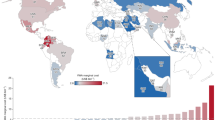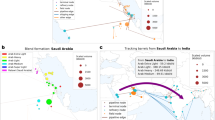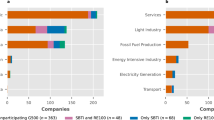Abstract
Oil and gas companies have claimed to be part of the transition to renewable energy. Our analysis of the energy assets of 250 of the largest oil and gas companies finds a marginal contribution to global renewable energy deployment and that renewable generation represents a tiny proportion of the total energy production of these companies. This study empirically legitimizes doubts about the commitment of the industry to transition to low-carbon energy production.
This is a preview of subscription content, access via your institution
Access options
Access Nature and 54 other Nature Portfolio journals
Get Nature+, our best-value online-access subscription
$32.99 / 30 days
cancel any time
Subscribe to this journal
Receive 12 digital issues and online access to articles
$119.00 per year
only $9.92 per issue
Buy this article
- Purchase on SpringerLink
- Instant access to full article PDF
Prices may be subject to local taxes which are calculated during checkout


Similar content being viewed by others
Data availability
Data have been sourced from public online databases including Urgewald Global Oil and Gas Exit List 2024 (https://gogel.org/) and GEM wind February 2025 version (https://globalenergymonitor.org/projects/global-wind-power-tracker/download-data/), solar February 2025 version (https://globalenergymonitor.org/projects/global-solar-power-tracker/download-data/), hydropower April 2024 version (https://globalenergymonitor.org/projects/global-hydropower-tracker/download-data/) and geothermal trackers September 2024 version (https://globalenergymonitor.org/projects/global-geothermal-power-tracker/download-data/). Additional data on company ownership have been sourced from Refinitiv Eikon (https://eikon.refinitiv.com/), a subscription-based product. The minimum corporate ownership information to replicate the analysis is provided in Supplementary Table 4, but the product licence terms do not allow for a full release of the raw data. Source data are provided with this paper.
Code availability
The R code is available via GitHub at https://github.com/llavero-pasquina/Oil-and-gas-industry-s-marginal-share-of-global-renewable-energy.
References
Van Asselt, H. & Green, F. COP26 and the dynamics of anti-fossil fuel norms. WIREs Clim. Change 14, e816 (2023).
Guo, Y., Yang, Y., Bradshaw, M., Wang, C. & Blondeel, M. Globalization and decarbonization: changing strategies of global oil and gas companies. WIREs Clim. Change 14, e849 (2023).
Halttunen, K., Slade, R. & Staffell, I. We don’t want to be the bad guys’: oil industry’s sensemaking of the sustainability transition paradox. Energy Res. Soc. Sci. 92, 102800 (2022).
Lamb, W. F. et al. Discourses of climate delay. Glob. Sustain. 3, e17 (2020).
Megura, M. & Gunderson, R. Better poison is the cure? Critically examining fossil fuel companies, climate change framing, and corporate sustainability reports. Energy Res. Soc. Sci. 85, 102388 (2022).
Supran, G. & Oreskes, N. Assessing ExxonMobil’s climate change communications (1977–2014). Environ. Res. Lett. 12, 084019 (2017).
Bonneuil, C., Choquet, P. L. & Franta, B. Early warnings and emerging accountability: total’s responses to global warming, 1971–2021. Glob. Environ. Change 71, 102386 (2021).
Bukold, S. The Dirty Dozen—The Climate Greenwashing of 12 European Oil Companies (Greenpeace, 2023); https://www.greenpeace.org/static/planet4-italy-stateless/2023/08/48ce4213-report-the-dirty-dozen-climate-greenwashing-of-12-european-oil-companies.pdf
Halttunen, K., Slade, R. & Staffell, I. Diversify or die: strategy options for oil majors in the sustainable energy transition. Energy Res. Soc. Sci. 104, 103253 (2023).
Fattouh, B., Poudineh, R. & West, R. The rise of renewables and energy transition: what adaptation strategy exists for oil companies and oil-exporting countries?. Energy Transit 3, 45–58 (2019).
Pickl, M. J. The renewable energy strategies of oil majors—from oil to energy?. Energy Strategy Rev. 26, 100370 (2019).
Green, J., Hadden, J., Hale, T. & Mahdavi, P. Transition, hedge, or resist? Understanding political and economic behavior toward decarbonization in the oil and gas industry. Rev. Int. Political Econ. 29, 2036–2063 (2021).
Christophers, B. Fossilised capital: price and profit in the energy transition. New Political Econ. 27, 146–159 (2022).
Oil & Gas Producers Welcome Historic Paris Agreement (IOGP, 2015); https://www.iogp.org/wp-content/uploads/2017/06/PR-IOGP-welcomes-agreement-2.pdf?_gl=1*n2g98x*_up*MQ
Hill, I. Part of the solution... International Association of Oil & Gas Producers https://www.iogp.org/blog/opinions/part-of-the-solution/ (2021).
Renewable Capacity Statistics 2025 (IRENA, 2025); https://www.irena.org/-/media/Files/IRENA/Agency/Publication/2025/Mar/IRENA_DAT_RE_Capacity_Statistics_2025.pdf
UNFCCC. Decision 1/CMA.5 Outcome of the First Global Stocktake https://unfccc.int/sites/default/files/resource/cma2023_16a01E.pdf?download (United Nations, 2023).
York, R. & Bell, S. E. Energy transitions or additions?: Why a transition from fossil fuels requires more than the growth of renewable energy. Energy Res. Soc. Sci. 51, 40–43 (2019).
Slameršak, A., Kallis, G., O’Neill, D.W. & Hickel, J. Post-growth: a viable path to limiting global warming to 1.5 °C. One Earth 7, 44–58 (2024).
Levenda, A. M., Behrsin, I. & Disano, F. Renewable energy for whom? A global systematic review of the environmental justice implications of renewable energy technologies. Energy Res. Soc. Sci. 71, 101837 (2021).
Newell, P. Trasformismo or transformation? The global political economy of energy transitions. Rev. Int. Political Econ. 26, 25–48 (2019).
Unit Converter (IEA, 2024); https://www.iea.org/data-and-statistics/data-tools/unit-converter
Acknowledgements
We thank K. O’Malia, S. Prasad and A. Mowat from Global Energy Monitor for very helpful comments and assistance with accessing and understanding the GEM trackers. M.L.P. discloses support for the research of this work from a M. Salas fellowship from the Spanish Ministry of Universities, from the Holberg Price 2023 awarded to J. Martínez-Alier, from the Maria de Maeztu grant (CEX2019-000940-M) awarded to ICTA-UAB by the Spanish Ministry of Science and Innovation, from the Ford Foundation (Grant 150866) and from Ministerio de Ciencia e Innovación - Gobierno de España (Grant TED2021-132007B-I00). A.B. acknowledges funding from the FI-SDUR 2020 464 scholarship awarded by the Catalan AGAUR Agency.
Author information
Authors and Affiliations
Contributions
M.L.P. conceptualized, designed and performed the analysis. M.L.P. produced the figures and tables. M.L.P. and A.B. contributed to data collection. A.B. assisted in the analysis. Both authors wrote the paper.
Corresponding author
Ethics declarations
Competing interests
The authors declare no competing interests.
Peer review
Peer review information
Nature Sustainability thanks H. Heede and the other, anonymous, reviewer(s) for their contribution to the peer review of this work.
Additional information
Publisher’s note Springer Nature remains neutral with regard to jurisdictional claims in published maps and institutional affiliations.
Extended data
Extended Data Fig. 1 Company operating renewable energy ranking coloured by type of company.
Aggregated data from Supplementary Table 5.
Extended Data Fig. 2 Map of utility-scale renewable energy projects owned by the world largest 250 oil and gas companies, their subsidiaries and acquisitions.
Panel a) shows the unique projects currently in operation (n = 1107), while panel b) shows unique projects in construction, pre-construction or announced (n = 899). Points are colour coded by technology and the size of the point is proportional to the ownership-adjusted installed capacity (total 78 GW in operation and 320 GW in the pipeline). The list of projects can be consulted in Supplementary Table 5. Basemap from OpenStreetMap.
Extended Data Fig. 3 Percentage of projects participated by the largest 250 oil and gas companies by technology and project size.
The percentage of projects with one or more oil and gas company owners (black) is given above its respective bar. The figures are calculated based on Global Energy Monitor (GEM) data, which tracks utility scale power plants only. The total number of projects documented in GEM for each category is given in brackets under each column, and next to the power capacity ranges of each category.
Extended Data Fig. 4 Share of global renewable energy capacity owned by the largest 250 oil and gas companies and their sister companies.
The percentage refers to the aggregate contribution by oil and gas companies, their acquisitions, and sister companies. Sister companies are defined as companies owned by the controlling parent of an oil and gas company. 94% of renewable capacity from sister companies can be attributed to Chinese state-owned power companies (Supplementary Table 1).
Extended Data Fig. 5 Company operating renewable energy ranking coloured by technology.
Full figures in Supplementary Table 2.
Extended Data Fig. 6 Schematic methodology.
Data input (green) and outputs (blue) are highlighted. Main figures are shown in a rectangle.
Supplementary information
Supplementary Information
Supplementary Methods.
Supplementary Tables
Supplementary Tables 1–6.
Source data
Source Data Fig. 1a and Extended Data Fig. 4
Aggregate capacity figures for each section of the piecharts.
Source Data Fig. 1b
Aggregate capacity figures for each section of the piecharts.
Source Data Fig. 2
Aggregate energy extraction figures for each company and energy source.
Source Data Extended Data Fig. 1
Renewable energy capacity figures by company and technology.
Source Data Extended Data Fig. 2
Renewable energy projects with longitude, latitude, equity capacity, status and technology attributes.
Source Data Extended Data Fig. 3
GEM project counts by technology, capacity range and oil and gas owners.
Source Data Extended Data Fig. 5
Renewable energy capacity figures by company and type of ownership.
Rights and permissions
Springer Nature or its licensor (e.g. a society or other partner) holds exclusive rights to this article under a publishing agreement with the author(s) or other rightsholder(s); author self-archiving of the accepted manuscript version of this article is solely governed by the terms of such publishing agreement and applicable law.
About this article
Cite this article
Llavero-Pasquina, M., Bontempi, A. Oil and gas industry’s marginal share of global renewable energy. Nat Sustain (2025). https://doi.org/10.1038/s41893-025-01647-0
Received:
Accepted:
Published:
DOI: https://doi.org/10.1038/s41893-025-01647-0



